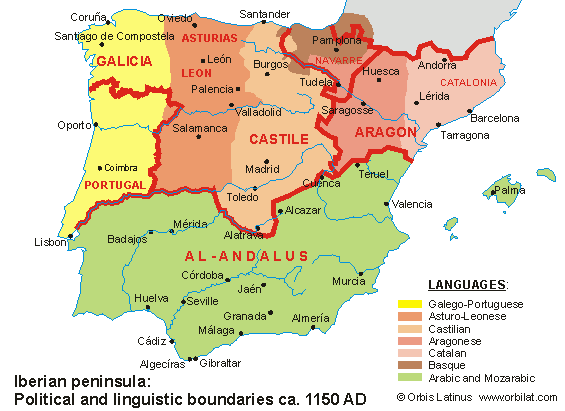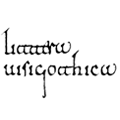Visigothic script vs. Caroline minuscule. Context (II)
As promised, here is the second post about the political and religious aspects that led to the change from Visigothic script to Caroline minuscule, now especially focused in Galicia.
The first post with a general approach to the topic, considering the Peninsula as a whole, was last week, and do not miss the one about the medieval roads of Galicia by which the influence of the new writing system “physically” arrived, and the other one about how the interaction took place, graphically speaking.
*
In the first part of this post, I wrote about how the combination of religious and cultural aspects, as well as specific political circumstances, collided determining the progressive disappearance of Visigothic script along the Iberian Peninsula. The gradual process of change started in the Astur or the Castilian-Leonese Kingdom before the first written testimony in Caroline minuscule was drawn; when the ‘national’ script was already odd if not completely vanished in Catalonia and Septimania.

See http://ballandalus.wordpress.com/2014/03/17/linguistic-and-cultural-diversity-of-medieval-iberia-900-1500/
Since the mid-11th century, the influence of Caroline minuscule can be seen in what it is called the transitional variant, a Visigothic minuscule script with some letters from the Caroline minuscule alphabet, some abbreviations like the superscripted letter or the signs for the end of -us by semicircle or even semicolon, Tironian signs, and a different general shape of the script. This ‘carolinisation’ was growing quickly, but it was not equal in all the peninsular northern territories, as each one reacted in its own way to the external influence.
Previous studies published [1] regarding, specifically, the study of Visigothic script in Galicia, state that the influence of the Caroline minuscule script can be seen in early 12th c., with few examples preserved after 1150 written in Visigothic script. The last example being from 1199 makes Galicia, like Toledo, the last stronghold of Visigothic script in the Iberian Peninsula. Although this information is not entirely accurate – the influence of Caroline minuscule dates back to 1070, thus late 11th and not early 12th, and Caroline was not the main script until the second half of the 12th c., thus not since the early 12th and not with few examples in Visigothic script after 1150; and finally, the last example in Visigothic script dates from 1234 and not 1199 –, it clearly reflects one of the main reasons why Galician manuscript sources are exceptional for studying the script’s evolution: the process of change from Visigothic script to Caroline minuscule was here slower than in any other part of the Iberian Peninsula – it took more than a century! (129/164 years lapse between the first and last examples in transitional Visigothic script) –, and, since both scripts were in use simultaneously for generations, the graphic influence was a continuous development that can be studied thoroughly, step by step. However, what the studies published so far do not highlight is the other main reason: that this interaction between the scripts was graphically, and not only chronologically, different among the two main centres in the region, Lugo and Santiago, which reflects the cultural context of Galicia during the 11th and 12th centuries. The reaction to the aspects mentioned (the connection with France, Cluny, Rome…) was not the same in both dioceses: Lugo, the traditional Galician diocese which had just lost territory and its political and cultural prominence with the restoration of the sees of Braga and Orense (c. 1070), in which the new changes arrived slowly under Alfonso VI, and Santiago, the radiant diocese built as a major point of communication with Europe.
With the change of dynasty, Astur to Navarre, Bermudo III (1027-1037) to Fernando I (1037-1065), the assimilation of Galicia into the Castilian-Leonese kingdom was difficult; the local nobility did not easily support changes promoted with centralised force that could jeopardize their power, making it therefore essential for the new kings to establish a safe control over the outbreaks associated with foreign supporters, to build their own new nobility, and to make alliances with the Galician church. Indeed, in Lugo, after the revolt led by Count Rodrigo Ovéquiz in 1085 (who had plotted with William I of England to hand Galicia to him), the king promoted Bishop Amor (1088) [2] granting him the lordship over the town in 1089 and successive privileges strengthening episcopal authority, protecting capitular property, and regulating markets, while, in return, he engineered reforms within the ecclesiastical administration of the diocese to reassert control over diocesan territories, as well as in the liturgy and, also, the script, appointing henceforth a succession of foreign priors to the Cathedral Chapter. The early 12th century was not a good moment for the diocese, allied with Alfonso el Batallador in the civil war, thus, against the future king Alfonso VII and Santiago, but, even so, changes continued with Bishop Pedro III (1113-1133), a former chaplain of Queen Urraca, under whom the first charter in Caroline was written (by Pelayo, entitled episcopal notary in 1122), and Bishop Guido (1135-1152, former prior), who was of French origin and under whom the change from Visigothic to Caroline finally took place.
In the meanwhile, in Santiago, the foreign and, especially, French influence was stronger and the changes quicker, as the diocese evolved as a peregrination centre since the invention of the apostolic tomb in the mid-ninth century. Although, at first, the Francophile political orientation of Alfonso VI was not well received by the diocese, under Bishop Diego Peláez (1071-deposed) who was a little intimidated by the pressure of Cluny in the kingdom, in the late 11th century the pro-European future of the diocese was already determined under the administration of Xelmírez, secretary and chancellor of Raymond of Burgundy, while the see was vacant. In 1093 Bishop Dalmatius succeeded Diego; Dalmatius was a Cluniac monk appointed by the king in alliance with Pope Urban II and Abbot Hugh of Cluny, who achieved for the diocese the privilege of exemption from metropolitan jurisdiction (Braga), placing it directly under the authority of Rome. A couple of years after his death the see was, finally, under Xelmírez, named bishop in 1100 (ł 1140), who, quoting R. Fletcher, “had the wit to see that his world was changing and the intuition to grasp how change might be made to serve his apostle’s – his own – purposes” [3]. Describing the administrative transformation of the diocese under Xelmírez would be another post and I think it is not needed since we have the exceptional Saint James’s Catapult: The Life and Times of Diego Gelmírez of Santiago de Compostela online. Regarding what concern us here, it is enough to say that he reformed the Cathedral Chapter and school of Santiago following French models, bringing to the, since 1124 archiepiscopal see, foreign masters who, without doubt, were not used to the old script, and that this reorganisation, as well as the Cistercian ‘colonization’ of Galicia, were fully developed in the mid-12th century.
[1] M. Lucas Álvarez, “Paleografía gallega. Estado de la cuestión”, Anuario de Estudios Medievales 21 (1991): 419-469 (441, 445).
[2] For this paragraph J. D’Emilio, “The Cathedral Chapter of Lugo in the Twelfth and Thirteenth Centuries: Reform and Retrenchment”, in R. A. Fletcher, Cross, Crescent And Conversion: Studies On Medieval Spain And Christendom In Memory of Richard Fletcher, Leiden 2008, 193-226. Especially 200-201 (footnote 35), 202.
[3] R. A. Fletcher, Saint James’s Catapult: The Life and Times of Diego Gelmírez of Santiago de Compostela, New York 1984, 6.
by A. Castro
[edited 11/07/2018]

